CucinaRebecca
... fabulous food, eating, cooking, wine and LUNCH!
Wednesday, August 30, 2006
Sunday, August 27, 2006
Five things to eat before you die

This is one of them.
Helen tagged me on Melissa’s project at The Travellers Lunchbox and it certainly has captured the imaginations of food bloggers worldwide.
So here’s my contribution, and I’ve tried not to replicate some already mentioned in the growing list, like fresh porcini, dim sum in Hong Kong, the Muffuletta from the Central Grocery in New Orleans, fried zucchini flowers, proper buffala, the ubiquitous truffle (white and black), and meals at various prominent restaurants.
All of which I love and adore and thank you to everyone who’s already mentioned them, I agree wholeheartedly.
This freshwater crayfish is some of the finest crustacean eating you will experience. Shaped not unlike a Maine Lobster or Homard Lobster, it’s sweet flesh is equally succulent boiled or grilled.
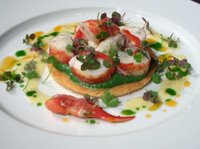
Here’s a Tarte Fine of Marron as prepared by the very talented Manu Feildel of Bilson’s Restaurant in
 2. Mussel Boys Restaurant in
2. Mussel Boys Restaurant in
New Zealand Green Lipped mussels are great eating. They’re reputedly very good for you too nutritionally, and contain a natural substance that helps with arthritis. I don’t care, the health benefits aren’t going to put me off, because they taste fantastic. Problem is, all the exports are frozen so they tend to be tough and I reckon tasteless. Fresh, however, is a different story. This restaurant is across the road from the Marlborough Sounds where the mussels grow in the crystal clear, deep, unpolluted waters. You can’t get fresher than that. It’s a little shack with an outside courtyard at the back and you can usually choose from 4 varieties of “flats” – grilled on the half shell – and 4 varieties of “steamers” tumbled piping hot into a bowl. Fresh bread, sunshine, with the best sauvignon blanc you will ever taste. Bliss.
 3. New potatoes and cloudberries on midsummer weekend in
3. New potatoes and cloudberries on midsummer weekend in
Sometimes you have a food experience that makes you re-assess your good fortune and what you otherwise take for granted. In Oz we have new potatoes at the drop of a hat. In
 4. Têtes de Violin as they come into season in
4. Têtes de Violin as they come into season in
Also eaten in
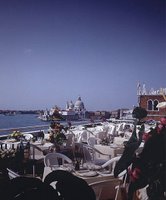 5. Risotto di Gamberi at the balcony restaurant at the Hotel Danielli, overlooking the Venetian Lagoon.
5. Risotto di Gamberi at the balcony restaurant at the Hotel Danielli, overlooking the Venetian Lagoon.
There’s something quite special about risotto in
And the runners up are ….
 It’s so hard to choose. Here are the ones that were very, very close, but didn’t make my list. Proper Gratinée in a
It’s so hard to choose. Here are the ones that were very, very close, but didn’t make my list. Proper Gratinée in a
To tag: If you haven’t already been bitten, I’d love to hear what your 5 musts are:
Jules at Stone Soup
Vicious Ange – if such thoughts don’t bring on morning sickness
Kate from Vegie Friendly
Ed from Tomato
Deborah from The Food Palate
And if you haven’t read it, Stephen Downes book To Die For is one critic's attempt to do what we’re doing here. But he gets to name 100.
Friday, August 25, 2006
Bombay Heritage
I’m going to blame Helen because I have to blame someone. The Essential Ingredient used to be one of my biggest and most frequent shopping indulgences. And because I lived close to its previous incarnation, I went past it so frequently it was very easy to think of something absolutely … well … ‘essential’ that I needed to acquire for my kitchen or pantry. In the cold light of day, I now realise these things are ‘essendulgences’, to coin a phrase. Now that Satan’s Emporium has moved to Crows Nest, I hardly think about it. I’m not reminded of its existence, way over there on the other side of the harbour. Until Helen put up her post about her shopping trip. Since then I haven’t been able to get it out of my mind, darn it. Crows Nest – hah! – if only it were that hard to reach. Maybe if it moved to Andean Condor’s Nest I’d be ok.
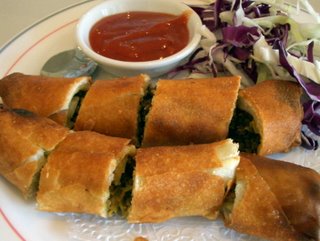 Koliwara Rolls
Koliwara RollsAs Oscar Wilde said, the only way to get rid of temptation is to yield to it. So off I went to scratch my itch, as it were. I won’t elaborate on the gory details, for that would be like a recovering alcoholic publicly recounting an ‘off the wagon’ night at a pub. But I will tell you about lunch.
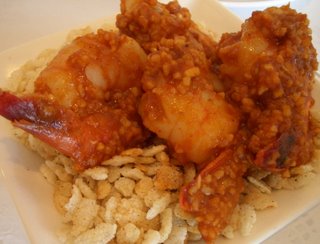
Garlic Prawns
I used to work in Crows Nest, so it was kind of nice to stroll down Willoughby Road and see what’s become of some of the restaurants I used to haunt. Many of them are still there, and they’ve certainly glamorised the streetscape with outdoor seating and clipped potted plants. The restaurant we visited was an old favourite of mine that’s been resident for about 18 years – a real stayer in Sydney restaurant terms. The food was just as fine as I remembered it, although I’m perplexed as to why they garnish everything with red cabbage. Not to worry, I can look past that.
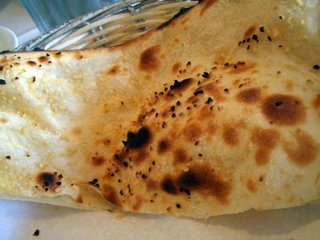
Garlic Naan
Being lunchtime, we went with a selection of entrée dishes to pick at and share. The garlic prawns ($10.50 for 4) are tossed in garlic, butter and a tomato based sauce, and served on a bed of flat rice (chiwra) which is a snack-like, beaten rice product often used as a cereal. It’s crispy, like a mini rice bubble that’s been run over by a steam roller.
The octopus (picture below, $9.50) is marinated and cooked in ginger and chilli oil, then chilled and served cold as a salad. It’s incredibly tender and redolent of fenugreek and curry leaves.
The koliwara rolls ($7.50 for 2 large rolls, sliced into 4 pieces each) are a Bombay tradition, and can be described as the filling of a lamb samosa but in the shape and pastry of a spring roll, fried ‘til crisp, and served with a chilli tomato sauce.
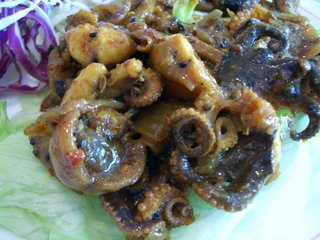
We couldn’t resist the chicken tikka, (picture below, $9.95 for 4 thigh pieces) fluorescently tinted with the trademark tandoori burnt orange, fresh and hot from the tandoor, with a smooth aromatic mint, cumin and yoghurt sauce. A flaky garlic naan bread ($2.95) completed our little selection of snacks for lunch, and we left feeling refreshed after all that hard shopping…
…but with enough energy left for a spin ‘round Simon Johnson in Pyrmont for the things that TEI doesn’t stock … Ortiz anchovies, Joseph’s first run Olive oil … oh god, I really do have it bad.

Bombay Heritage
82 Willoughby Rd.,
Crows Nest,
Lunch Tuesday-Friday from 12 pm
Dinner 7 nights from 6pm
Take away Available (10% discount)
Local area delivery available.
Red lantern
 This little Surry Hills gem has been one of my favourite restaurants for a few years. Down the increasingly gentrified strip of Crown Street, the bland facades give way to a deep scarlet renovated terrace with a beckoning dark, mysterious, lacquered interior. A couple of outside terraced steps provide some outdoor tables streetside, and the languid shadowy room, heavily decorated in nouveau Saigon opium den style, offers inside seating in an intimate but noisy dining space.
This little Surry Hills gem has been one of my favourite restaurants for a few years. Down the increasingly gentrified strip of Crown Street, the bland facades give way to a deep scarlet renovated terrace with a beckoning dark, mysterious, lacquered interior. A couple of outside terraced steps provide some outdoor tables streetside, and the languid shadowy room, heavily decorated in nouveau Saigon opium den style, offers inside seating in an intimate but noisy dining space.There are many reasons I keep coming back to Red Lantern. Having discovered it way before the TV series Heat in the Kitchen, which made it almost impossible to get a table there for months, it’s not just the funky interior design that pleases, but the cuisine which while innovative, firmly keeps its roots planted in traditional Vietnamese style. Secondly, in my humble opinion I think this restaurant does THE best chilli salt squid in Sydney. I know that’s a big call, but every single time I dine here I order it and it never lets me down. And thirdly there’s the rest of the menu. While I haven’t sampled everything, the food is extremely tasty but not over spiced, and with so many delectable fresh vegetables and salads that you can convince yourself without too much trouble that you’re eating healthy.

M & J were my lunch companions celebrating J’s promotion (yay!) and M is a pescatarian or (vegaquarian if you prefer). The exclusively vegetarian section of the menu has eight items, and there are more choices for the fish eaters. Even for the goi cuon or papaya salad they’re happy to serve the dish without the pork, so it’s eminently adaptable for some additional non-meat choices.
 True to form the first order was the Muc Rang Muoi or chilli salt squid (above $16) – a tumbling mountain of crisply flash-fried melt-in-the mouth squid pieces, with a palate-reviving, sit-up-and-take-notice lashing of salt and chilli. The squid is served with an aromatic and astringent lemon and pepper sauce, which I dip about every 4th piece of squid in because it packs a punch.
True to form the first order was the Muc Rang Muoi or chilli salt squid (above $16) – a tumbling mountain of crisply flash-fried melt-in-the mouth squid pieces, with a palate-reviving, sit-up-and-take-notice lashing of salt and chilli. The squid is served with an aromatic and astringent lemon and pepper sauce, which I dip about every 4th piece of squid in because it packs a punch. 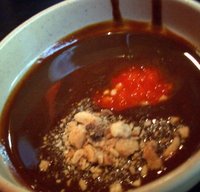 The goi cuon – rice paper rolls (left, $12 for three) – with yamba prawns present a translucent tease of shellfish, perilla (or shiso) leaves and garlic chives, hiding shredded greens and vermicelli in the interior. Dipped into the home made hoi sin sauce it’s light, crunchy and succulent.
The goi cuon – rice paper rolls (left, $12 for three) – with yamba prawns present a translucent tease of shellfish, perilla (or shiso) leaves and garlic chives, hiding shredded greens and vermicelli in the interior. Dipped into the home made hoi sin sauce it’s light, crunchy and succulent.Given M’s dietary preferences I had the chance of getting past my favourite entrées of crisp spiced quail and the crisp parcels of pork and chicken, but I can thoroughly recommend them as well.

Goi Du Du or green papaya salad with prawns and fresh herbs (left, $16) offers a cascade of papaya with golden fried crispy shallots and garlic, tangy spice, a dousing of chilli, and aromatic herbs. We’re still hungry, so we order the Man Xao Nam Dong Co – wok tossed bamboo shoots, shiitake mushrooms and bok choy in oyster sauce (below, $13.50). I ask for a bit of tofu to be thrown in because I love it so much, no problem. Served with steamed rice, the meaty mushrooms and slickly sticky rich oyster sauce are a great contrast to the crunchy bamboo slivers. The rice soaks up the abundant sauce.

There’s a wealth of other choices at Red Lantern: the ever popular Pho and the traditional Vietnamese style crispy pancakes with various fillings that you can play with at the table. There are also clay pot fish and chicken dishes, wok fries, and goat curry (the latter I think is definitely an acquired taste). And at these reasonable prices you can afford to go back and try many options – if you can manage to give up the chilli salt squid addiction you are bound to develop!
Red Lantern
545 Crown St.,
Surry Hills
9698 4355
Open for lunch from 12.30pm Tues-Fri
Dinner, Tues – Sun from 6.30pm.
Monday, August 21, 2006
Doyles at Circular Quay
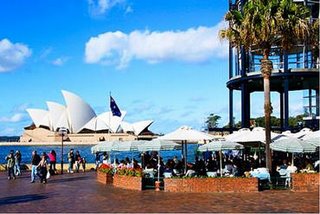
Last year Matthew Evans, the Sydney Morning Herald’s former restaurant critic and editor of the Good Food Guide, severely panned Doyles, giving it a single digit score out of 20 and a scathing review. At the time I thought it churlish of him, yet brave, because this was prior to the changes in NSW’s defamation laws. I feel slightly protective of Doyles because I’m a member of the family. Jack and Alice Doyle, who started their business in 1948 at the old Watson’s Bay tea rooms and Ozone Café site, were my Great Uncle and Aunt.
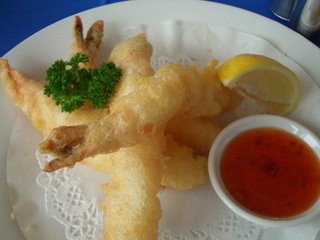
Tempura battered prawns
If you’re just off the airbus from Old Blighty, clutching your Visa card because it’s the only thing they’ve let you take on board the plane, your luggage is en route to Venezuela, and you fancy being waited on while you have a nice sit in the sun and some fish and chips (with a great view) … well need I say more. You don’t scour the dining guides and start a spreadsheet comparison, you go to Doyles. When you want to take Granny out for an airing for her 85th and everyone including the great grandkids are lobbing in, you don’t look for the eight course degustation with white linen napery, you go to Doyles coz then Gran knows it’s a special occasion and you can get everything from live lobster to fish nuggets with tomato sauce. You pay for the ease, the convenience, the options, the history, the location, and the view – and quite often they give something decent to eat as well.
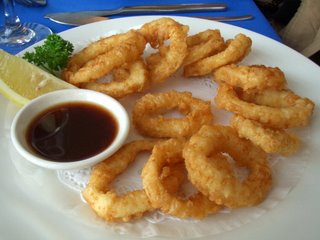
Any time I’ve taken friends from far off climes, who are not total food sluts like me, out to lunch to really show off the harbour, I take them to Doyles. They always say they’ve heard of it. Half the time they don’t taste what they’re eating because they’re too busy gawping and taking pictures. Once they’re used to the whole
 Cold Mixed Entree plate.
Cold Mixed Entree plate.I adopt the KISS principle when dining at Doyles: the simpler, the better. If you want oysters or prawns stuffed with all manner of foreign objects and smothered in sauces before being baked to death, you only have yourself to blame. Just have plain prawns, or at a pinch tempura battered, natural
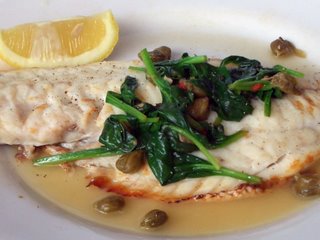
G had the cold mixed entrée ($19.50) which comprised prawns, smoked salmon and oysters. I don’t know what they were thinking with the orange slice, but it seemed to be the garnish du jour. Apart from the ubiquitous curly parsley, a touch you rarely see at fine diners these days. Clearly Doyles keeps the fragile curly parsley industry from collapsing. Not a lot can go wrong with putting cold seafood on a plate if it’s fresh, and it was, and very nice too. Tick. MN had calamari ($17.70) – as you can see a triumph of food styling – but despite the aesthetic, perfectly tender with a crunchy crisp batter. Tick. I had tempura prawns ($18.20) which I couldn’t resist re-arranging slightly for a picture because they obviously came from the same plating hand responsible for the calamari. Sweet, juicy and tender, crispy batter, but not a bit like proper Japanese tempura. Half tick.
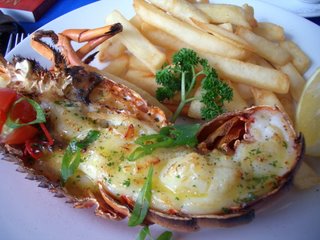
G had the
Doyles do some things really well – the plainer, unfussy things that simply show off the seafood for what it is. I imagine some of the other choices are on the menu because they’re popular and trendy, but they’re not better than the old fashioned things. To this day I still make Auntie Alice’s seafood cocktail sauce, as per her recipe, if I serve cold seafood. It’s a classic and always will be. Kind of like Doyles. Curly parsley, doilies, iceberg lettuce. It represents a particular choice for the superannuated and tourist alike. It's reliably open and has attentive staff. It's consistent. It serves seafood. That’s what it’s trying to achieve.
Sunday, August 20, 2006
Ma Po Tofu
 Then there’s Ma Po Tofu, which is ‘pockmarked grandmother bean curd’, named after the Chinese woman who created the dish. Sounds enticing, doesn’t it? Well don’t let a few pox put you off. This is wedged firmly in the ultra comfort food section of the Chinese palate. A Sichuan dish, it’s also spicy and the Sichuan ‘peppercorns’ (which are not related to black pepper at all and are the buds of a prickly ash grown in Northern China) leaves an irresistible, slightly anaesthetic, tingle through your mouth.
Then there’s Ma Po Tofu, which is ‘pockmarked grandmother bean curd’, named after the Chinese woman who created the dish. Sounds enticing, doesn’t it? Well don’t let a few pox put you off. This is wedged firmly in the ultra comfort food section of the Chinese palate. A Sichuan dish, it’s also spicy and the Sichuan ‘peppercorns’ (which are not related to black pepper at all and are the buds of a prickly ash grown in Northern China) leaves an irresistible, slightly anaesthetic, tingle through your mouth.
4 spring or green onions
2 cloves of garlic
4 tablespoons of Spicy Bean Sauce (also often helpfully marketed as Ma Po sauce)
1 tablespoon of Hoi Sin sauce
2 tablespoons Shao Xing rice wine
1 teaspoon of sugar
200 mls Chicken stock
1 small brick (about 200–250g) firm tofu
1 tsp corn flour mixed with a little water
1 tbsp peanut oil
Pinch of ground
 I love to have this dish with fresh rice noodles, but you could use any type of noodle or rice. The rich spicy sauce and the slippery soft, smooth tofu creates a fantastic texture and flavour contrast. Pok marked she may be, but this granny is one you would want to give you a big hug on a cold night. A word of warning, through: because the
I love to have this dish with fresh rice noodles, but you could use any type of noodle or rice. The rich spicy sauce and the slippery soft, smooth tofu creates a fantastic texture and flavour contrast. Pok marked she may be, but this granny is one you would want to give you a big hug on a cold night. A word of warning, through: because the
Saturday, August 19, 2006
Seville orange and Calvados marmalade
 This month’s sugar high Friday theme is preserves. I’m not really much of a jam girl, but I do love a good marmalade. Seville oranges are the best for marmalade because of their bitterness and now (in the southern hemisphere) is the best time to make it because the levels of pectin – the substance that makes jam set – in the fruit are at their highest. Bitter oranges were bought to Spain by the Arabs and their cultivation in Spain has led to the common name of Seville oranges. A highly perfumed tree when in blossom, its other uses include the production of orange flower water and as the base for liqueurs like Cointreau, Grand Marnier, Curacao and Triple Sec. The zest also contains a substance that acts as an appetite suppressant.
This month’s sugar high Friday theme is preserves. I’m not really much of a jam girl, but I do love a good marmalade. Seville oranges are the best for marmalade because of their bitterness and now (in the southern hemisphere) is the best time to make it because the levels of pectin – the substance that makes jam set – in the fruit are at their highest. Bitter oranges were bought to Spain by the Arabs and their cultivation in Spain has led to the common name of Seville oranges. A highly perfumed tree when in blossom, its other uses include the production of orange flower water and as the base for liqueurs like Cointreau, Grand Marnier, Curacao and Triple Sec. The zest also contains a substance that acts as an appetite suppressant. I can never resist putting a splash of something into jams or preserves just to zhuush up the taste. Calvados is a French apple brandy that became a firm favourite of mine when I worked at a restaurant that specialised in food from Normandy, which is where they make calvados. So I guess with this recipe I’m … uh … comparing apples with oranges and showing it really can work.
I can never resist putting a splash of something into jams or preserves just to zhuush up the taste. Calvados is a French apple brandy that became a firm favourite of mine when I worked at a restaurant that specialised in food from Normandy, which is where they make calvados. So I guess with this recipe I’m … uh … comparing apples with oranges and showing it really can work.This recipe produces a fine rather than chunky marmalade as the only fruit that’s in it are the finely sliced slivers of zest. The rest of the fruit is important in the cooking process to extract the pectin from the pips and pulp to allow the marmalade to set. The yield is about 1-1 ½ litres.
1.5 kg Seville oranges (about 8)
1.5 – 2 litres water, to cover the zest and muslin bag
Sugar (see recipe for amount) about 1 kg
1/3 cup calvados
Remove the outer skin (zest) from the oranges with a peeler and slice it into thin (julienne) strips. Juice the oranges and chop the pith that’s left and put the orange pips and pith into muslin cloth and tie it tightly. In a non reactive pan place the muslin bag, julienned zest and juice with the water and bring to the boil. Turn down to a simmer and let it bloop away gently for an hour or 90 minutes, or until the liquid is reduced by a third and the zest is tender. Allow to cool completely, overnight if you like, then squeeze out the muslin hard into the liquid and extract as much juice out of it as you can. Throw away the muslin and its contents.
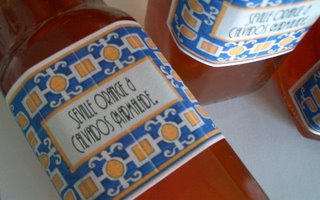 Measure the remains of your pan in cups/mls and add the equivalent volume amount of sugar. For instance, if you have one litre of liquid left add a one litre volume of sugar. Place over the heat and stir until dissolved then boil fairly rapidly – a rolling boil – for 15 – 20 minutes or until the marmalade reaches setting point. To test for setting point place a saucer in the freezer for a few minutes then take it out and put a blob of marmalade onto it. Leave it for a minute and push it with the tip of your finger. It should have a wrinkled skin that’s formed on top. The pectin levels of this fruit are so high it should be pretty easy to reach setting point. Add the calvados and decant into sterilised jars.
Measure the remains of your pan in cups/mls and add the equivalent volume amount of sugar. For instance, if you have one litre of liquid left add a one litre volume of sugar. Place over the heat and stir until dissolved then boil fairly rapidly – a rolling boil – for 15 – 20 minutes or until the marmalade reaches setting point. To test for setting point place a saucer in the freezer for a few minutes then take it out and put a blob of marmalade onto it. Leave it for a minute and push it with the tip of your finger. It should have a wrinkled skin that’s formed on top. The pectin levels of this fruit are so high it should be pretty easy to reach setting point. Add the calvados and decant into sterilised jars.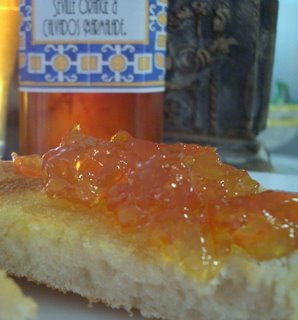
This is a beautifully bitter marmalade with a fine texture and lingering flavour. I love it on plain buttered sourdough toast with a cup of black unsweetened Earl Grey tea.
Wednesday, August 16, 2006
Hubris and the Hailstorm.
 A cautionary tale.
A cautionary tale. As it piled up on my balcony and the rooftops, I atoned to the gods and apologised for my fair weather
Mea culpa, mea culpa, mea maxima culpa. It’s an average harbour and weather’s ok. And I’ve woken up with a head cold. Serves me right.
Tuesday, August 15, 2006
Aria
 With what must be one of the most spectacular views in Sydney, Aria also presents some of the city’s most spectacular food.
With what must be one of the most spectacular views in Sydney, Aria also presents some of the city’s most spectacular food.On a faultless Sydney winter’s day (about 22°C, just to make the Melburnians green) you have a soprano’s eye view of the Opera House and a vista of the Coathanger (the Sydney Harbour Bridge) across the sparkling harbour waves. No wonder tourists are breathless at the sight of it, and even as a Sydneysider you do forget how gawpingly magnificent it is. If you look on Aria’s website you can see a neat little virtual panorama of the view from the main dining room. From the private dining room, where I was seated you look out over the Bridge only (poor me). On this occasion I was a guest of Open Thinkers of Australia, so this was a working lunch, but despite the brain strain and idea sharing, I had time to take in the equally stunning culinary vistas laid before me. Being a serious occasion my pix are a bit quick and dirty and it definitely wasn’t the sort of gig where I could taste other people’s plates with impunity or grill (no pun intended) others about the nuances of their meals.
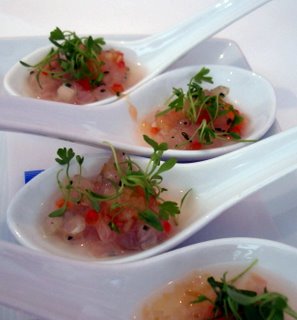 Tartare of Hiromasa Kingfish with trout roe
Tartare of Hiromasa Kingfish with trout roeAn amuse bouche of tartare of Hiromasa Kingfish with trout roe whetted the appetite admirably. Here you can read the lunch menu, and on the main website some mouth watering food photography illustrates a selection of the dishes.
 Scallop tortellini with mushroom puree and pine nut and leek salad
Scallop tortellini with mushroom puree and pine nut and leek saladI started with scallop tortellini (left) with mushroom puree and pine nut and leek salad. Near translucent, silky, fresh egg pasta enclosing just cooked scallop pieces on a cushion of scented and delicately meaty mushroom morsels.

Roquefort cheese salad with pear The roquefort cheese salad with pear, witlof and walnut dressing comprised a perfectly caramel pear with salty chunks of cheese in an artwork of composed leaves.
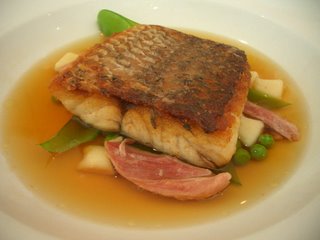 Baked barramundi with pea and ham consommé and baby gnocchi I followed with the baked barramundi with pea and ham consommé and baby gnocchi. The crispest skin uppermost, the full flavoured fish floats like a cloud in a delicately limpid flavoured broth with shards of slow cooked hock and emerald pea islands. The tiny gnocchi were almost lost however when I tried the side dish of desiree potato and truffle mash.
Baked barramundi with pea and ham consommé and baby gnocchi I followed with the baked barramundi with pea and ham consommé and baby gnocchi. The crispest skin uppermost, the full flavoured fish floats like a cloud in a delicately limpid flavoured broth with shards of slow cooked hock and emerald pea islands. The tiny gnocchi were almost lost however when I tried the side dish of desiree potato and truffle mash. 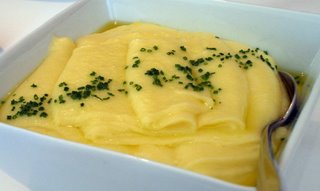
Desiree potato and truffle mashThe lingering heady scent of truffles infused through the downiest potato silk I have ever sampled. Lolling like a plump cream duvet, snug in its bowl and ringed by buttery lakes it was heaven. Not a lump, not a bump it melted along the tongue to leave its truffle infused memory for the remainder of the afternoon.
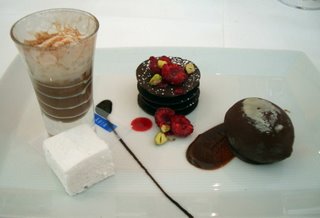 Assiette of Valrhona chocolate
Assiette of Valrhona chocolateAnd the dessert. Like sets from one the operas next door, the kitchen’s creative juices were let loose with dessert presentation. Still life with sugar, the story of endless and minute attention to detail as the finale to a memorable meal. I had to have the assiette of Valrhona chocolate – three mini masterpieces of ice cream coated with crisp chocolate coating, a raspberry and chocolate stack and a warm frothed hot chocolate. My head was spinning. However I did manage to get pictures of some other desserts.
Bombe alaska with pistachio and Chestnut ice cream and citrus salad.
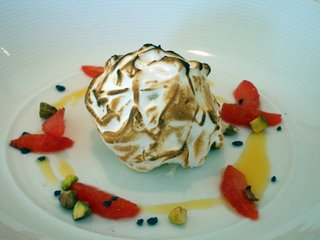
Mandarin jelly with raspberries and yoghurt sorbet
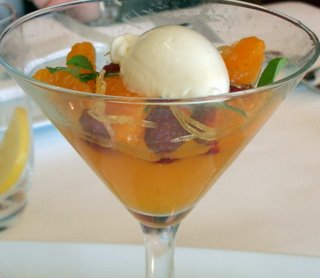
And to finish with coffee, the daintiest plate of petits fours imaginable. And the view.

Aria
No 1 Macquarie St, Sydney.
Friday, August 11, 2006
Frangelico crème caramel with hazelnut praline
 If you live here in Oz, you might have seen this recipe in the food pages of last weekend’s Australian Magazine. The minute I saw it, I drooled. I’ve knocked up a few crème caramels in my time, but this twist looked and sounded just sumptuous. The recipe is the creation of the recently crowned Lexus Young Chef of the Year, Beau Vincent, who rattles the pans at Restaurant Assiette in Surry Hills, Sydney. More about him in a future post. Frangelico is an Italian hazelnut flavoured liqueur.
If you live here in Oz, you might have seen this recipe in the food pages of last weekend’s Australian Magazine. The minute I saw it, I drooled. I’ve knocked up a few crème caramels in my time, but this twist looked and sounded just sumptuous. The recipe is the creation of the recently crowned Lexus Young Chef of the Year, Beau Vincent, who rattles the pans at Restaurant Assiette in Surry Hills, Sydney. More about him in a future post. Frangelico is an Italian hazelnut flavoured liqueur.The recipe as printed didn’t quite do it for me in terms of texture and depth. As an all milk version, it was a little thin and watery, not as rich and creamy as this dessert is traditionally presented. So here is my revised version which I think steers the dish more towards a lush crème. I’ve also added a few more cooking clues for anyone who hasn’t made this beast before. And if you haven’t, it’s a very easy preparation and brings miles of enjoyment to your tastebuds.
The toffee:
200g sugar
Splash of water just to moisten the sugar
Put this on the stove in a small saucepan and stir until the sugar has dissolved. Use a metal or pale ceramic pan, not a non stick pan, because if the pan is black you’ll never be able to tell when the toffee gets to the right colour. Let it come to a medium boil and bubble away for 10-15 minutes until the liquid sugar starts to go from clear to golden brown. It’s really important that you don’t touch the boiling sugar. Just let it bubble and don’t go near it with a spoon, despite crusty sugary bits forming round the sides of the pan. You can muck around with brushing the sides with a silicone brush or monitoring with sugar thermometers, but you really don’t need to bother. As the sugar changes colour, don’t leave the pan. Watch as it colours and take it off the stove when it reaches a dark golden brown. About the colour of honey. The sugar will keep cooking as you work, so take it off earlier rather than later if you're in doubt. Hold your ramekin in your hand, protecting it with a tea towel or mit. Liquid toffee is very hot and the heat transfer from the ramekin may burn your hand. Pour a little sugar into the base of the ramekin – about 1-2 tablespoons. Put the toffee pan down and turn the slightly tilted ramekin with your hand so the toffee coats the inside of the ramekin as well as the base. It will set very quickly and harden up the sides. Keep going til you’ve coated all the ramekins. My ramekins are 150 ml capacity and I found this recipe made 4 generously filled desserts. You could stretch it to 6 with a bit less filling in each.
Once the toffee is in, place the ramekins in a baking dish lined with a folded over teatowel. You’ll be baking in a bain marie and this helps protect the delicate custard from burning.
The custard:
250 mls whole milk
250 mls full fat (35% milk fat) cream
60 mls (3 tablespoons) of Frangelico
1 egg
3 egg yolks
80g caster sugar
Mix the milk, cream and Frangelico together and warm through for about 5 minutes – don’t let it boil. Whisk together the eggs and sugar (only whisk the eggs and sugar at the last minute as sugar can ‘cook’ egg yolks if they’re in contact for too long and you’ll end up with little hard bits in your custard) and pour in the warm cream mixture, whisking constantly. Fill the ramekins (I find it easier to pour the mix into a jug with a good spout and fill them this way) and then pour boiling water into the baking dish so it comes half way up the sides of the ramekins. Bake in a 160°C oven (140°C fan forced) for 35-45 minutes or until the custard is set. Remove from the oven and dish, allow to come to room temperature then chill for several hours or overnight.
For the praline, roast 300g hazelnuts in the oven, rub their skins off with a teatowel, place them on a baking sheet lined with baking paper, then cover the nuts with another batch of sugar toffee, made exactly the same way as described above. In fact if you’re really organised you can do the nuts and the ramekins with the same batch of toffee. Let the toffee set hard, break into pieces and blitz it in the food processor until you have fine praline crumbs.
 The reveal: Take the caramels out of the fridge and gently with your thumb or fingers pull the custard slightly away from the sides of the ramekin all the way around. Fingers are better than knives here as you’re likely to hack up the custard with a knife if you’re not really careful. Place your serving plate over the caramel, hold the ramekin, and flip it the right way up. Give it a vertical shake while holding the ramekin onto the plate and you’ll here the squelch as the caramel releases from the ramekin. As you lift off the ramekin the golden liquid toffee will drizzle over the caramel and the plate, revealing the pale custard and brown sugar-stained top. Ooooohhhh Errrrrr.
The reveal: Take the caramels out of the fridge and gently with your thumb or fingers pull the custard slightly away from the sides of the ramekin all the way around. Fingers are better than knives here as you’re likely to hack up the custard with a knife if you’re not really careful. Place your serving plate over the caramel, hold the ramekin, and flip it the right way up. Give it a vertical shake while holding the ramekin onto the plate and you’ll here the squelch as the caramel releases from the ramekin. As you lift off the ramekin the golden liquid toffee will drizzle over the caramel and the plate, revealing the pale custard and brown sugar-stained top. Ooooohhhh Errrrrr.Sprinkle over the praline and serve with a little glass of Frangelico. Yum scrum.
(Also, any left over praline is fantastic stirred through good vanilla ice cream. Yum x 2).







